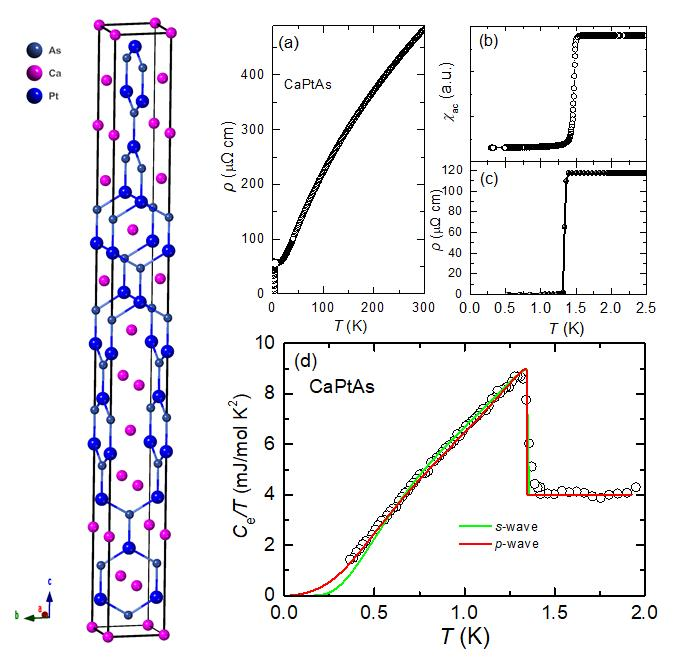Feb 26 2020
At Zhejiang University, China, a team of researchers has discovered that CaPtAs, a noncentrosymmetric compound, is a superconductor, exhibiting evidence for strange properties. This compound offers a new possibility to analyze unconventional superconductivity in systems that have a broken inversion symmetry.
 Left: Crystal structure of CaPtAs. Right: Temperature dependence of the (a) resistivity between 300 K and 0.3 K, (b) ac-susceptibility, and (c) resistivity below 2.5 K of CaPtAs. (d) Electronic contribution to the low-temperature specific heat of CaPtAs, fitted using a p-wave model. Image Credit: © Science China Press.
Left: Crystal structure of CaPtAs. Right: Temperature dependence of the (a) resistivity between 300 K and 0.3 K, (b) ac-susceptibility, and (c) resistivity below 2.5 K of CaPtAs. (d) Electronic contribution to the low-temperature specific heat of CaPtAs, fitted using a p-wave model. Image Credit: © Science China Press.
The physical properties of a compound can be considerably influenced by the lack of an inversion center in its crystal structure. The fascinating phenomena that arise include the lifting of a Dirac point’s four-fold degeneracy in Weyl semimetals to yield two doubly degenerate Weyl nodes, spin-splitting of the Fermi surfaces, the typical properties of noncentrosymmetric superconductors, and magnetic skyrmions with complex spin textures.
Since 2004, when the first example of this family of materials with powerful electronic correlations was found by E. Bauer et al., noncentrosymmetric superconductors have been analyzed extensively.
The symmetry-enabled antisymmetric spin-orbit coupling (ASOC) in such a superconductor that lacks an inversion center enables the admixture of spin-singlet and spin-triplet pairing states, which can result in a nodal superconducting gap.
This has been found in the weakly-correlated noncentrosymmetric superconductors Li2(Pt, Pd)3B. H. Q. Yuan et al. discovered that the ASOC’s strength can regulate the relative strengths of the triplet and singlet components in the superconducting pairing wave function.
In the recent past, researchers have discovered a growing number of noncentrosymmetric superconductors that exhibit exclusive properties. It has been theoretically predicted that of these, some systems potentially have topological superconductivity.
In recent times, noncentrosymmetric superconductors in which weak correlations exist but time-reversal symmetry vanishes below the superconducting transition temperature have been discussed a lot. But a majority of the other characteristics of these systems seem to be similar to those of traditional BCS superconductors, including a completely open superconducting gap. The source of this strange behavior is yet to be explained.
A team of researchers headed by Prof. Huiqiu Yuan from the Center for Correlated Matter (CCM) and Department of Physics at Zhejiang University have identified a new noncentrosymmetric superconductor, CaPtAs, with prospective unconventional pairing. The study titled “CaPtAs: a new noncentrosymmetric superconductor” has been reported in SCIENCE CHINA: Physics, Mechanics & Astronomy.
CaPtAs, which belongs to the alkaline-earth based equiatomic ternary compounds, crystallizes in a noncentrosymmetric tetragonal structure (space group I41md, No.109) with three-dimensional (3D) honeycomb networks.
This differs from compounds like BaPtAs, BaPtSb, and SrPtAs, which exhibit structures made of stacked hexagonal honeycomb layers. Both single- and poly-crystals of CaPtAs have been produced by researchers successfully, and bulk superconductivity has been confirmed below the temperature of 1.5 K.
Quantification of thermodynamic properties points toward prospective nodes in the superconducting gap, where the electronic specific heat is fitted well by a p-wave model. At present, further joint studies are underway to identify the nature of the superconducting pairing state of CaPtAs.
This study was funded by the National Key R&D Program of China (Grant Nos. 2016YFA0300202, and 2017YFA0303100), the National Natural Science Foundation of China (Grant Nos. U1632275, and 11874320), the Science Challenge Project of China (Grant No. TZ2016004), and the Fundamental Research Funds for the Central Universities.